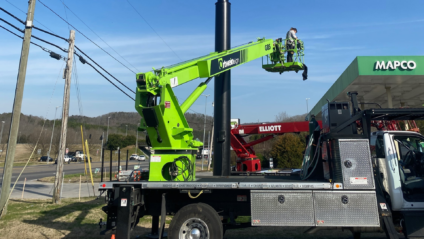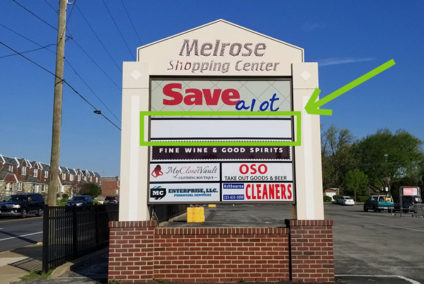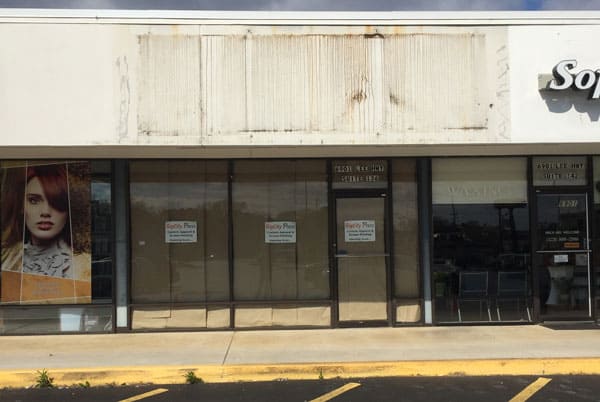Closing a business — whether due to retirement, relocation, or new opportunities — is a big step. While there’s paperwork to file and assets to sort, one often-overlooked task is the signage. Here’s what business owners (and landlords) need to know about what comes next for your sign.
1. Determine Sign Ownership After Business Closes Shop
If you’re unsure who owns the sign, your lease agreement is the first place to check. Many commercial leases clearly outline sign ownership, including who is responsible for its installation, maintenance, and eventual removal. Did the landlord purchase and install the sign? Did you? Was it part of a buildout allowance? Is there one sign or are there multiple signs — for instance, one on the building and one on a monument or tenant panel — and if so, who owns which? Establishing clear ownership will help you understand not only who is responsible for removal but also whether you’re entitled to keep or reuse the signage. If responsibilities aren’t clearly spelled out in the lease, this is a good time to clarify expectations with your property manager or legal counsel. you started this business, you already may know the answer offhand; however, you’ll want to ensure you understand who owns your business sign. This may determine whose job it is to remove said signage. Did the landlord purchase and install the sign? Did you? Was it part of a buildout allowance? Is there one sign or are there multiple signs, and if so who owns the one on the building and if there’s a monument or tenant panel who owns that sign? You’ll want to determine all of this.
2. Notify Your Sign Company Early

We know it may not seem like the first thing that comes to mind when closing a business; however, you’ll want to schedule your signage removal early to ensure it’s removed in a timely fashion. In particular, if your landlord requires you to remove the sign — which is commonly stipulated in lease agreements — failing to do so could result in penalties or extended liability. Reviewing your lease for any sign removal clauses is key, as many agreements specify a timeframe for removal and outline whether restoration of the building facade is required. Being proactive helps avoid misunderstandings and ensures that signage is handled responsibly before vacating the property. We know it may not seem like the first thing that comes to mind when closing a business; however, you’ll want to schedule your signage removal early to ensure it’s removed in a timely fashion. In particular, if your landlord requires you to remove the sign, then they may also penalize you after a period if the sign remains after your closure date.
3. Sign Removal and Building Facade Repairs: What to Expect
Lease agreements often include stipulations regarding the condition in which a tenant must leave the property — and this frequently extends to signage. After removing a sign, there may be damage such as ghosting, mounting holes, or discoloration left on the facade. These conditions could trigger restoration requirements depending on your lease. Signs mounted directly to the building can be more intrusive, so it’s worth noting that many landlords prefer signage mounted to a raceway. Raceways reduce the number of wall penetrations and minimize potential facade damage, making them a cleaner and more lease-friendly option. If your lease requires repair or restoration after sign removal, be sure to budget for patching, repainting, or even cleaning the area — especially if the sign was installed long ago. Always review your lease and communicate with your landlord to clarify expectations before your move-out date.
Though landlords often prefer sign types that limit damage, and thus are easy to replace, you may still need to check with your landlord or your lease if you are on the hook for any repairs following the removal of your sign. Long lasting signs in particular can leave ghosting, holes potentially, or other types of damage to the facade, so you’ll want to ensure if that’s your responsibility.
4. What Happens to Business Signage After a Company Closes?
Since you’ve determined sign ownership by this point, you’ll know whether it’s your sign or your landlords to deal with. If it’s yours you may have the option to keep the sign should you choose, either as a keepsake or if you’re moving locations, and simply closing that particular one, you may be able to see if its up to codes with your new location. If it is, you can hire a company such as Ortwein Sign to not only remove the sign but check permitting and if allowable to reinstall it at your new location. If you simply want it removed, we can do that, and if you no longer want the sign we can also help dispose of the sign.
5. What Should Commercial Property Owners Do with Tenant Signage After a Business Closure?

First, refer back to your lease agreement to confirm whether the tenant was responsible for signage removal and any associated facade restoration. Clear clauses in the lease about signage removal and repair help prevent ambiguity when a tenant departs. If the lease lacks such details, this is a strong argument for updating future agreements to include specific sign responsibilities.
If your tenant’s sign is still up, consider interim steps. In retail plazas or multi-tenant monuments, some landlords invert or reverse tenant panels to signal vacancy. Others opt for temporary “For Lease” inserts. Once the sign is removed, it’s an ideal time to clean or repair the building facade—especially if the sign left behind ghosting, staining, or mounting holes. Signage mounted on raceways typically results in less damage and simpler cleanup, which is why many landlords specify raceways in their tenant requirements.
Finally, think about long-term visual appeal and consistency. A clean, uniform sign setup not only improves curb appeal but helps attract future tenants. This might be a great opportunity to reassess the property’s signage guidelines, ensuring they support both branding needs and property preservation goals.?
If you’re a property manager and you’re responsible for the signage, then everything above may pertain to you. If the signs were your tenants, you may still want to consider what to do with the signage in the meantime. Some businesses for monuments or pylons in particular will turn said signs upside down (or upside down and backwards) to signify they’re closing. You may also want to consider getting a blank one, or if it makes sense a “For Lease” sign. If your tenant’s signage is removed too, this may be a good opportunity to look into cleaning the facade. Even if there’s a raceway that a new sign can be installed on, you might find there’s dirt, moss, or bird nests you’ll want cleaned so as to present a more attractive storefront for your next tenant.
6. What Should New Tenants or Business Owners Do with Existing Signage?

If you’re a new tenant or business inheriting signage from a previous occupant, don’t assume it’s ready to go. First, check local sign codes and permitting requirements — the sign may need updates to comply. Review your lease to confirm who is responsible for sign updates, removal, or reinstallation. Even if the sign is functional, you may want to rebrand it to match your business identity. A qualified sign company like Ortwein Sign can inspect the existing signage and advise whether it’s better to retrofit, reuse, or replace.

